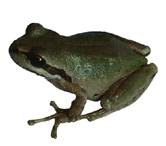
MONDAY, March 11 (HealthDay News) — Salmonella-infected African dwarf frogs from a California breeding facility sickened hundreds, and potentially thousands, of children and adults from 2008 to 2011, federal officials report.
Many of the children, whose average age was 5, were hospitalized with severe illness.
Parents should be cautious about pet frogs, which are often kept in home aquariums, and amphibians and reptiles in general, warned Shauna Mettee Zarecki, lead author of a new report and a public health advisor with the U.S. Centers for Disease Control and Prevention.
“Families just weren’t aware that there was a risk from these frogs or reptiles or amphibians in general,” Mettee Zarecki said. “Any amphibians, particularly these frogs, should not be in homes where there are children less than 5 years old.”
Medical researchers found 376 cases of infection with a type of salmonella in 44 states from 2008 to 2011. More than two-thirds were children under the age of 10.
Salmonella is spread by a bacteria and causes diarrhea, abdominal cramps and fever that can last for several days, Mettee Zarecki said. Most people recover after about a week, but some need to be hospitalized, and the disease can be deadly.
About 30 percent of the infected people in this outbreak were hospitalized. Fortunately, none died.
Diagnosing the strain of salmonella requires testing a stool sample, and many physicians and patients don’t bother to take that step, Mettee Zarecki said. For that reason, the CDC doesn’t know how widespread the outbreak actually was. But previous research suggests that there may be 16 cases for each reported case, making it possible that this outbreak affected some 6,000 people.
The researchers linked the outbreak to a frog breeding facility in Madera County, Calif. The CDC didn’t identify the facility, and Mettee Zarecki said it’s not clear how the salmonella infection spread to the frogs, which transmitted it through their feces.
Children are especially vulnerable to salmonella, Mettee Zarecki said, and it appears that they were infected through contact with contaminated water from frog habitats, such as aquariums.
Dr. Robert Frenck, professor of pediatrics with the division of infectious diseases at Cincinnati Children’s Hospital Medical Center, noted that it’s possible to be infected with salmonella by drinking contaminated water. But it seems to be more commonly transmitted either from food contaminated with the bacteria or direct contamination of the hand that subsequently goes in the mouth, said Frenck, who was not involved with the study.
In one case, a family cleaned an aquarium in the same kitchen sink that they used to bathe their child and kept baby bottles nearby. The child became infected and was hospitalized.
Owners of the frogs should empty and wash aquariums outside the home to avoid infecting sinks and bathtubs. And because any amphibians or reptiles could carry salmonella, they shouldn’t be around kids under 5 at all, Mettee Zarecki said, nor around anyone who has a weakened immune system.
“There have been a number of outbreaks associated with a variety of pets, and amphibians have been known to carry salmonella. We always try to tell people that reptiles like turtles and snakes are a significant source of potential infection,” she said. “But this is the first time they have been linked to an illness on this scale.”
Dr. Pascal James Imperato, dean of the School of Public Health at SUNY Downstate Medical Center in Brooklyn, N.Y., recommends that children should not have certain kinds of pets, including chicks and ducklings.
“If [people] do buy them, they need to ensure that everyone in the household — children and adults — who have contact with them, should thoroughly wash their hands with soap and water after touching or handling them and the objects with which these pets come into contact, such as litter for chicks and ducklings, and terrarium materials for frogs and turtles,” Imperato said.
Also make sure that children don’t kiss the pets, he said.
The report was released online March 11 in advance of publication in the April print issue of Pediatrics.
More information
For more about salmonella, visit the U.S. National Library of Medicine.

